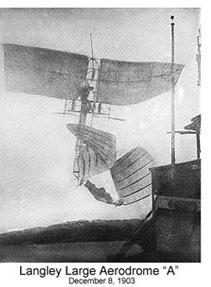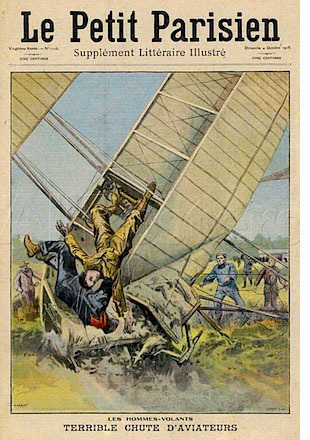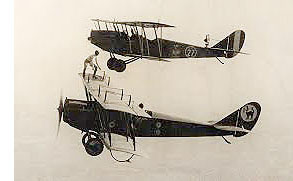The National Geographic Channel's "Wright Brothers vs Curtiss" (also referred to by NatGeo as "Wright vs Curtiss") aired this evening (June 1st), and it was - amazingly - worse than the trailers and episode clips led us to believe.
The visuals of the NatGeo production were, for the most part, done well, so if the viewer turned off the sound it might have been more engaging, even with the too-young Wilbur and all the glaring looks and quiet posturing - but assuming that viewers watched and listened, they were mercilessly abused with one wrong thing after another, one strange portrayal after another, and one topsy-turvy event after another.
While there are far too many fictional elements to chronicle in their totality, several will serve to illustrate that this program should not have been touted as a "documentary" - it is not.
Here are a few of the more egregious lapses... along with some missed opportunities that would have provided much needed depth to the story "Wright Brothers vs Curtiss" was floundering to tell.
1) Perhaps this writer's favorite bit of NatGeo nonsense was when the narrator, Jeff Wilburn, educated us all to the "fact" that
"No invention has changed the world quite like the airplane, but the story of its creation is one of intense rivalry, between two brothers named Wright..." "... and a dare-devil called Glenn Curtiss..." "... who was brave enough to take them on." "A bitter competition..." "... fueled by danger, and marked with tragedy, would forever change the way we see the world."
Note to "Wright Brothers vs Curtiss" production team - the aeroplane was created on December 17, 1903, when Wilbur and Orville Wright made the first powered, sustained, controlled human flights. There was no - zero - "intense rivalry" no - zero - "bitter competition" between Glenn Curtiss and Wilbur and Orville Wright when the Wrights invented the aeroplane/airplane.
Who would have thought this sort of gross error would pop up on the National Geographic Channel, of all places...
2) During the winter of 1885/86, Wilbur, 18, suffered a terrible injury from being slapped across the mouth by a hockey stick wielded by someone who would later be executed for committing multiple murders. Wilbur's front teeth were knocked out and his face was injured. This event changed the direction of his life, and could be argued that it resulted in the invention of the powered, controlled, heavier-than-air aeroplane.
So, what does "Wright Brothers vs Curtiss" have to say about this major event ? Nothing, not a peep.
 3) The two attempts to launch the engine powered Langley Large Aerodrome "A" with Charles M. Manly aboard, on October 7, 1903, and on December 8, 1903 - were failures caused by structural collapse, but that wasn't the only structural collapse...
3) The two attempts to launch the engine powered Langley Large Aerodrome "A" with Charles M. Manly aboard, on October 7, 1903, and on December 8, 1903 - were failures caused by structural collapse, but that wasn't the only structural collapse...
"Wright Brothers vs Curtiss" suffered one, also, by ignoring this major event... which happened only 9 days before Wilbur and Orville made the first powered, controlled and sustained human flights. The failure of the Langley Large Aerodrome "A" to fly with a human aboard provides a sharp contrast to the work of the Wrights - a large institution (the Smithsonian) on the one hand, and the two brothers, self-supporting their aeronautical work, on the other.
Does "Wright Brothers vs Curtiss" take advantage of this contrast ? Nope, not at all... there's not a mention of Langley and his Aerodrome "A."
However, perhaps there is another reason why the Langley Large Aerodrome "A" fails to put in an appearance... the notorious 1914 "tests" that Curtiss conducted using a substantially altered, rebuilt and strengthened Langley Large Aerodrome "A" in order to demonstrate that the Wrights weren't the first to fly. The notion was if the Langley Large Aerodrome "A" could be shown to have been flight-worthy, it would be evidence of "prior art" - which, in a patent suit, is an affirmative defense.
The use of the rebuilt and altered Langley Large Aerodrome "A" in this way caused a major rift with the Wrights and left a bad taste about Curtiss. It was, arguably, a low point in Curtiss' career.
So, mention of the Langley Large Aerodrome "A" would have brought up all that unpleasantness about Curtiss, and in keeping with the rampant pro-Curtiss bias of "Wright Brothers vs Curtiss" - that couldn't be tolerated.
4) In the part related to the 1908 Fort Myer, Virginia, US Army Signal Corps Aeroplane Trials, "Wright Brothers vs Curtiss" tells the viewer that...
"For Orville, the only way to win the contract is to win over Lt. Selfridge. With twelve successful test flights behind him, Orville is joined by Selfridge for the first official demonstration."
 There was no need to "win over Lt. Selfridge" - the flights at Fort Myer were to meet aeroplane acceptance specifications set by the US Army Signal Corps (not by Lt. Selfridge).
There was no need to "win over Lt. Selfridge" - the flights at Fort Myer were to meet aeroplane acceptance specifications set by the US Army Signal Corps (not by Lt. Selfridge).
"Wright Brothers vs Curtiss" seizes on the Fort Myer trials and the death of Lt. Selfridge as a major turning point in their fantasized version of reality. In doing so, they ignore that 5 days prior to the disastrous flight with Army Lt. Selfridge, Orville made a successful passenger flight with Army Maj. George O. Squire, and 8 days before with Army Lt. Frank Purdy Lahm.
Are those successful passenger flights mentioned ? Nope, they aren't.
The narrator says that...
"Over the course of one week, Orville completes a series of successful demonstrations. And on September 9th 1908, Orville flies for 62 straight minutes, crushing the record for sustained flight. And to boot, their biggest rival, Glenn Curtiss witnesses it all."
On September 12th, Orville made a spectacular flight lasting 1 hr. 15 min. 5 sec., and covering 50 mi., the longest flight of 1908.
Is that mentioned ? Nope, it isn't.
We're also told that...
"Curtiss is invited to the event by his good friend, Lt. Tom Selfridge."
In fact, Curtiss was at Fort Myer to assist "Uncle Tom" Baldwin with flying the large two-person airship that would become the "Signal Corps No. 1" - Curtiss operated the engine (one of his) while Baldwin controlled the airship's flight. Baldwin and Curtiss were at Fort Myer to meet the Signal Corps specifications for lighter-than-air aerial machines, just as Orville was present to meet the specifications for heavier-than-air aerial machines.
After the accident which severely injured Orville and caused the death of Lt. Selfridge, we're told that...
"For Glenn Curtiss the competition against the Wright brothers turns personal."
Aha ! Now it makes sense that none of the other true events were included in the Fort Myer story, because including those facts would have softened the drama of Curtiss losing his friend, Lt. Selfridge, and drama is the driving force behind "Wright Brothers vs Curtiss," not history.
And... where's Wilbur while all this is taking place at Fort Myer ? He's in France, astounding the aeronautical community there with his remarkable and beautiful flights.
Does "Wright Brother vs Curtiss" tell us what Wilbur is up to ? Nope, it does not.
Perhaps "Wright Brother vs Curtiss" believed that by adding Wilbur's remarkable public flights, they'd be diluting the drama of the fatal crash at Fort Myer, and, as just noted, drama is the driving force behind "Wright Brothers vs Curtiss," not history.
5) Perhaps the most fictional scene (there are so many...) offered to the viewer by "Wright Brothers vs Curtiss" is the one in which an anonymous government functionary tells Orville Wright and Glenn Curtiss, in 1917, the conditions of the government imposed patent pool agreement, as Orville Wright and Glenn Curtiss sit listening. Orville stiffens, clutches his hands on a folder and squirms, Curtiss looks at Orville and smiles.
Nope, didn't happen.
That is a wholly fictional event, concocted by "Wright Brothers vs Curtiss" and meant to convey that Curtiss had "won" the rivalry.
Two minutes using any web search engine would have turned up the fact that the patent pool of 1917 was between the Wright-Martin Aircraft Company and Curtiss. Orville (Wilbur passed away from typhoid in 1912) sold the Wright Company, along with the Wright Patent, to investors in 1915 and so was no longer involved when the patent pool was established and all the US aeronautical patents were put together and made available to all aviation manufacturers in the US - on the brink of the US entry into The Great War, World War I.
6) "Wright Brothers vs Curtiss" makes a plethora of silly and easily avoided mistakes, as when the narrator tells us that in the wake of the 1917 patent pool agreement,
"The government forces the Wright Company to share its patents with other manufacturers, including Glenn Curtiss. Curtiss is now free to build and sell his airplanes and reap the financial reward. His years of experimenting and innovation pay off. He sells an astounding 7,000 of his newly designed Jenny fighters for the victorious war effort."
Those are 'where-to-begin-the-corrections' sentences...
 Nearly 7,000 (6,813) Curtiss "Jenny" JN-4 (Canadian) and JN-4D of all types were built and while the "Jenny" became the standard trainer airplane with the US Army, it certainly was not a "fighter."
Nearly 7,000 (6,813) Curtiss "Jenny" JN-4 (Canadian) and JN-4D of all types were built and while the "Jenny" became the standard trainer airplane with the US Army, it certainly was not a "fighter."
7) As noted in "NatGeo Loses Its Compass" quite a number of very significant people are missing from this half-baked production... Octave Chanute, Augustus Moore Herring, Bishop Milton and Katharine Wright, Charles E. Taylor, and "Uncle" Tom Baldwin, to name just a few.
8) Incredibly, also missing is the greatest real rivalry between the Wrights and Curtiss. "Wright Brothers vs Curtiss" never even mentions the Wright Exhibition Company (February 1910 to May 1912) and the Curtiss Exhibition Company (June 1910 to November 1912). That was a true rivalry, between those teams of aviators who went across the country giving exhibitions of flight, in open fields, at race tracks, in ballparks, at fairs and at aeronautical contests.
It's not enough to claim that time is limited and so the story has to be winnowed down to its essentials. Making the story of the invention of the aeroplane/airplane into "A bitter competition..." between two individuals, Wilbur and Curtiss, (Orville has a very limited role in this production) is not only a falsehood, it misses the larger story, the one the NatGeo audience ought to have been told.
There is a Latin phrase which could serve as the motto for NatGeo's "Wright Brothers vs Curtiss"... "Reducitur ad rationem absurditas" - reduced to an absurdity.
9) The number of errors concerning aeroplanes/airplanes is remarkable. A late 1930's-1940's Stearman trainer biplane is shown in flight, presumably because it is a biplane and red, because it has no relationship at all to the narrative about WWI.
As noted, the JN-4 and JN-4D "Jenny" were not "fighters" as "Wright Brothers vs Curtiss" states, they were flight training aeroplanes.
The "June Bug" in "Wright Brothers vs Curtiss" is missing its vertical tail surface, and its propeller is barely turning over.
The mock aeroplane/airplane in which Orville is shown taking Lt. Selfridge for a flight, is controlled by a single joystick, instead of the two levers used on the Wright machine.
The Wright Patent covered a three-axis control system for aeroplanes/airplanes, not simply wing-warping as "Wright Brothers vs Curtiss" seems to say.
Etc... etc... etc...
10) In order to up the drama, "Wright Brothers vs Curtiss" chose to create a false narrative that somehow the title of "First in Flight" was the base motivator of Wilbur and Orville Wright. That contest ended before it began, on December 17, 1903, at Kill Devil Hill, North Carolina, when Wilbur and Orville Wright made the first successful, powered (by their own engine), controlled (by their three-axis control system) human flight.
Generally, throughout the production, motivations are fabricated, simplified and exaggerated. This might make for good tv, but as history, it's rotten compost.
11) Perhaps the biggest problem with "Wright Brothers vs Curtiss" is its unrelenting portrayal of Wilbur Wright as obsessed, stodgy and angry and Orville as ineffectual and dominated by his older brother, while portraying Curtiss in a completely positive light, in one scene after another, walking in heroic poses, in slo-mo no less, standing in a low-angle camera hero shot (complete with lens flares), being helpful to a worker, concerned with safety, a charming dare-devil "... who was brave enough to take them [the Wrights] on"... and so on.
_______
Near the end of "Wright Brothers vs Curtiss" the narrator remarks...
"The Wrights may have invented the airplane, but Glenn Curtiss has turned it into an industry."
No, there is no "may have" about it, the Wrights invented the aeroplane/airplane because they invented the means to control flight.
That use of "may have" betrays the underlying pervasive and unnecessary anti-Wrights and pro-Curtiss bias that infects this production... and removes from it the pretense of being a "documentary" - "Wright Brothers vs Curtiss" is not a documentary and it certainly isn't history, regardless of what NatGeo says.
People are free to be pro- or anti- Wrights or Curtiss as a matter of personal opinion, informed or not, but not as the central theme of a "documentary."
Consider the disclaimer NatGeo placed at the beginning of "Wright Brothers vs Curtiss"...
"This program includes dramatizations inspired by history. Some events have been altered for dramatic purposes."
It's nearly impossible to find even a handful of events in "Wright Brothers vs Curtiss" that weren't altered. You'd think NatGeo would know better, but NatGeo classifies this production as a documentary.
It's a pity that NatGeo and those who worked on "Wright Brothers vs. Curtiss" didn't make the effort to suppress their creativity and their love of fiction a bit and uphold the story as it truly was...
In this writer's opinion, the true story is far more compelling and engaging and of much greater meaning than the fictionalized novella NatGeo and Banijay/Stephen David Entertainment foisted off on NatGeo's viewers.

